Gluten-Free Crusty Boule
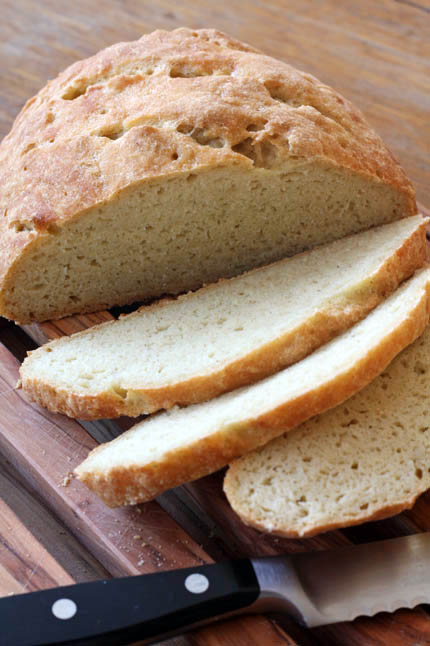
Gluten-free breads were a major request from readers of Artisan Bread in Five Minutes a Day. The options for buying gluten-free bread are both unsatisfying and expensive. So here is a wonderful bread that anyone, celiac or not, would want to eat.
Several readers have asked about the olive oil dough on page 302 of The New Healthy Bread in Five Minutes a Day. While the Crusty Boule (page 299 in the book) has a chewy and toothsome texture, the bread made with the olive oil dough has a much lighter, almost fluffy interior. Replace the neutral flavored oil in the Gluten-Free Crusty Boule recipe with olive oil if you prefer the texture of that loaf. They are both wonderful and give you fantastic options for free form loaves, sandwich breads, pizzas and even crackers. You will find all of these, plus many other gluten-free breads and awesome sticky buns in the book, with the link above.
For those of you who are celiac or just baking for someone who is you will find all of the directions and tips for handling gluten-free dough below. It is just as easy as the other recipes, but requires slightly different techniques and a new list of ingredients.
Gluten-Free Crusty Boule
Makes enough dough for at least four 1-pound loaves
2 cups Brown Rice Flour
1 1/2 cups Sorghum Flour
3 cups Tapioca Flour (also called tapioca starch)
2 tablespoons yeast (can be reduced but you will have to increase the rise time)
1 tablespoon kosher salt (increase or decrease to taste)
2 tablespoons Xanthan Gum
2 2/3 cups lukewarm water
4 large eggs, whisked together
1/3 cup neutral-flavored oil or olive oil
2 tablespoons honey or sugar
Click here to see the video of this recipe

Mixing and storing the dough: Whisk together the flours, yeast, salt and xanthan gum in a 5-quart lidded Round Food Storage Container. Combine the oil, honey and water, set aside.
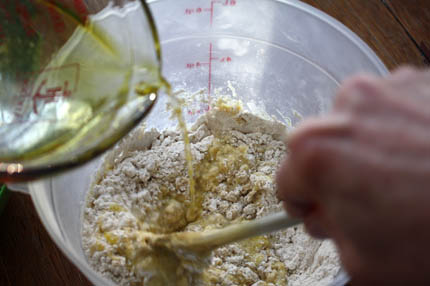
Dump the eggs into the dry ingredients and then stir while you pour in about 1/3 of the oil and water. Unlike my wheat doughs, do not add all of the liquid at once and stir. If you do, that will result in a lumpy dough.
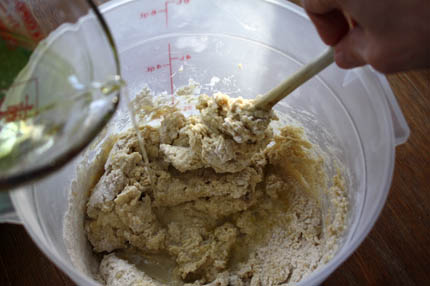
Continue to stir while you pour in another 1/3 of the liquid.
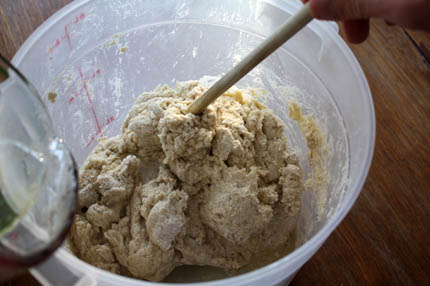
The dough will start to come together in a thick dough. Add the final 1/3 of liquid and
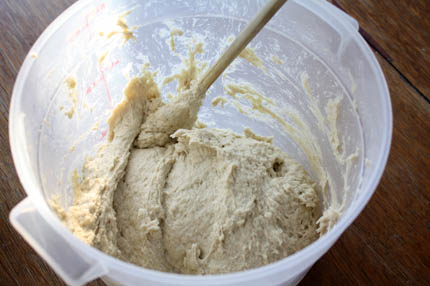
Stir until the dough is smooth. Cover with the lid, but do not snap it shut. Allow it to rest on the counter for about 2 hours. Place the dough in the refrigerator and store for up to 7 days. (I have a piece in the freezer and I will report back about how that turns out once I defrost it and bake it up. Stay tuned.)

On baking day take the bucket from the refrigerator. The dough will be quite fluffy still and you want to try not to handle the dough too much. Just like our other doughs the trick is to keep as much of the air bubbles in tact as possible.
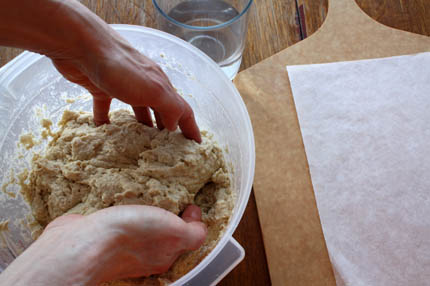
Use wet hands to remove 1-pound (grapefruit-size) piece of dough from the bucket.
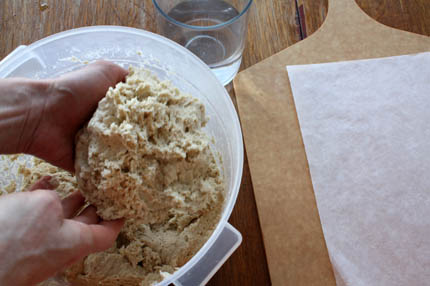
The dough will be quite scraggly when you take it out, just place it on a piece of parchment paper.
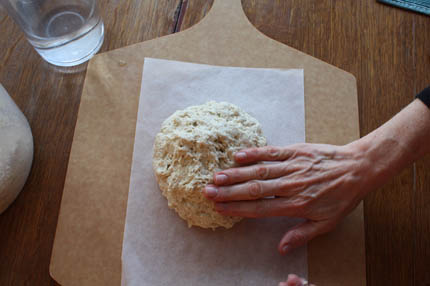
Use wet hands to smooth out the surface of the dough.
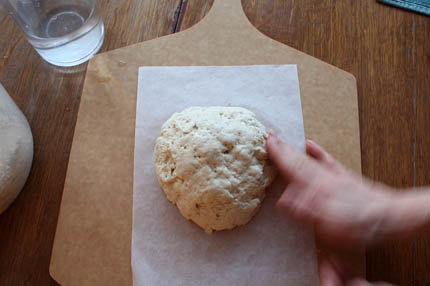
This may take dipping your hands in the water a few times…

to get a nice shape.
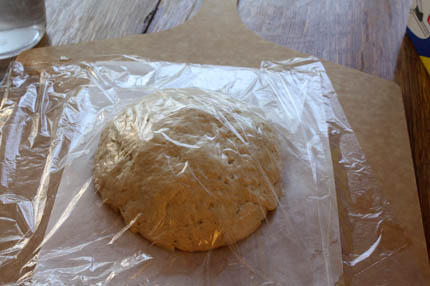
Cover loosely with plastic wrap and allow to rest on the counter for about 90 minutes. If your kitchen is very warm you may only need about 75 minutes.
30 minutes before baking time preheat the oven with a 5 1/2 quart Dutch Oven in it to 500 degrees. Be sure it is fitted with a metal Replacement Knob
, the original plastic knobs can only be heated to about 400 degrees. To find directions for baking on a stone see page 237 of HBin5.
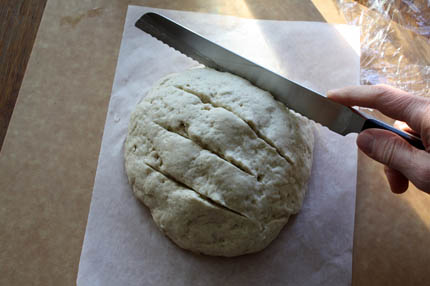
The dough will not have grown much while resting, but it will seem a little bit puffier. Use a serrated knife to cut slashes in the dough.
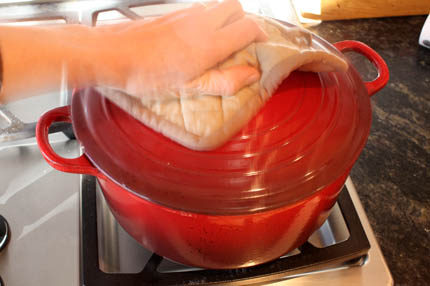
Remove the pot from the oven and take off the lid.

Lift the bread on the parchment and VERY CAREFULLY lower the parchment and bread into the pot, replace the lid onto the pot. Return to the oven and bake for 20 minutes. After the 20 minutes remove the lid, turn the heat down to 450 and bake for an additional 15 minutes.

Once the bread is done baking remove it from the pot using a spatula.
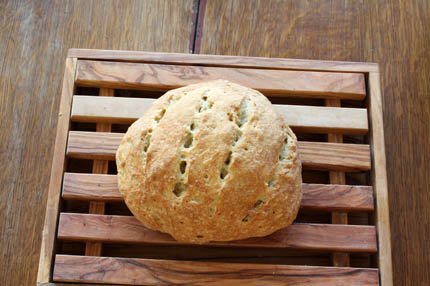
Allow the bread to cool completely before eating or the center may seem gummy.
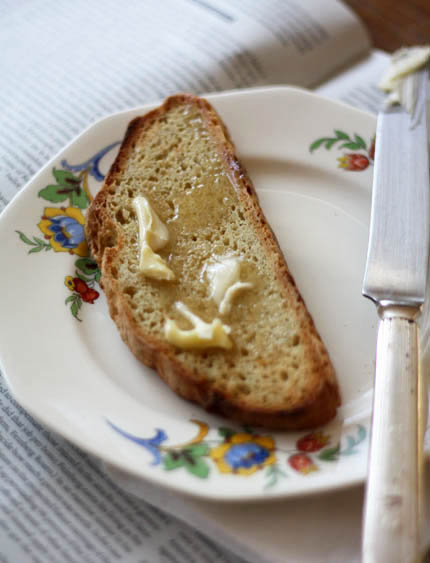
WEIGHTS for GLUTEN-FREE FLOURS
Brown Rice Flour: 1 cup = 5 1/2 oz = 155 grams
Tapioca Flour (Starch): 1 cup = 4 1/2 oz = 130 grams
Sorghum Flour: 1 cup = 4 3/4 oz = 135 grams
Cornstarch: 1 cup = 4 1/2 oz = 130 grams
Note: BreadIn5.com is reader supported. When you buy through links on the site, BreadIn5 LLC earns commissions.
Like Stephanie, I’m wheat-intolerant but not gluten-intolerant, and it’s really hard to find recipes to suit. It’s always assumed that if you can’t eat wheat it means you are gluten-intolerant. And like Stephanie I also can eat spelt. I have been buying some lovely breads which do suit my needs but they are incredibly expensive, so I bought the two Bin5 books to try to start making my own, so would love some advice on how to fully substitute the wheat ingredients with spelt, rye, etc. Stephanie, have you tried the xanthan gum yet?
Leonnie: Depends on what you are intolerant of. If it’s gluten, spelt may bother you as well since there’s gluten in it (though less than wheat). And you should be able to use xanthan gum to bolster structure in low-gluten flours like spelt. As you’ve noticed, the 100% spelt recipe in our book has vital wheat gluten, so if it’s gluten that you can’t use, this isn’t going to be for you. Ought to work well with xanthan gum but haven’t tried it myself… Jeff
I tried baking 2 lbs of this dough in a 9×5″loaf pan and as others have mentioned it doesn’t get much rise so I had a very thin loaf. I’m going to try it again with 3 – 4 lbs of dough and see if it will cook through so I can have a full sandwich size loaf. Do you think this will work? Or am I going to end up with a gummy mess that is overcooked on the outside?
Tina9: I’m always happier in our method when I make smaller loaves, they bake through better. Are you giving a full 90-minute resting time? Which of our recipes are you using?
Short answer: I’m with you, worried about gumminess for such a big loaf done in a loaf pan (which prevents the dissipation of internal moisture).
I use a smaller loaf pan, filling it 3/4 full to get a nice domed result, see https://tinyurl.com/c826ua, that’s the size I use.
A friend gave me the link to your site and the GF boule recipe. I am hoping to try it in the next week or so, but am wondering … I have two cast iron dutch ovens, one enameled (similar to your Le Creuset only different brand with molded handle) and one plain old seasoned cast iron. Does it matter which one I use? I think the seasoned cast iron might be more “nonstick” than the enameled one, but not sure. I just have to find myself one of those round lidded plastic containers and make room in the fridge for it (easier said than done, LOL) and then I should be set to go. Can’t wait to try making the GF boule — thank you for posting the recipe!
Franca: Either the Le Creuset or the seasoned cast iron work great, without sticking, doesn’t make much difference. Jeff
Loved your original recipe, but had to give it up when we opted to make our household gluten-free for my little boy who has celiac. So eager to try out this recipe!
Unfortunately, my former dutch oven substitute (an old crockpot with glass lid) met an untimely end when it fell off the shelf in the pantry.
How would I go about baking this free-form? Do I still need parchment paper? Start with a hot oven? And what temperature?
Thanks!
Rebecca: Parchment is nice but not absolutely necessary. In the book we specify parchment or cornmeal, and baking at 450 degrees with steam (start with a hot oven with a baking stone in place for best results. Jeff
Ok, I’m planning to give this a try later today with a silicon mat (warn me if this is not a suitable choice, and I’ll switch to parchment!) and will stick a pan of water on the bottom shelf. Improvising as always, for lack of equipment. 🙂
I swapped out the brown rice flour for millet, because I am never happy with brown rice flour in bread for some reason. Millet usually gives me a great loaf, so I’ll report back on this experiment later tonight!
Hi Rebecca,
I’ll be very interested to hear how your dough comes out. I find that the gluten-free flours have such different personalities in terms of their flavor and baking properties. I’ve never tried to substitute with millet. Let me know how your results are.
You can use a silpat, you just might need to take the loaf off at the end to crisp up the bottom crust.
Thanks, Zoë
I am interested in knowing whether you might be working on developing or adapting some recipes to be low-carb varieties?
Thanks!
Hi Becky,
Using the 100% whole grain recipes would be the closest that we have come up with so far. All flour is high in carbs so it is hard to bake a great bread without them. Adding some soy flour and other flours that are high in protein can be helpful as well.
Thanks! Zoë
A really interesting loaf. The flavor of the sorghum flour was really intense, and I liked it quite a bit. Are there other ways to incorporate sorghum flour or brown rice flour into other recipes in your books (even ways with gluten)? For example, could you substitute some sorghum flour into a regular loaf instead of some of the normal flour, and add extra gluten? I’d love to bake with them a bit more and see how their flavors influences other breads.
Hi Jebyrnes,
We have not played with it yet, but I think it is a great thing to experiment with. You are exactly right about needing to add more Vital wheat gluten to make up for the fact that sorghum has no gluten at all.
Please let us know how your experiments come out!
Zoë
Thanks, Jeff. I guess I may have used the wrong thread for my query because I’m not gluten intolerant, but purely wheat-intolerant. Therefore it’s the wheat content of the vital wheat gluten that is the concern, not the gluten. I’m fine with spelt, so if I substitute xantham gum in the spelt recipe can you suggest how much to use, and do you think it would be the same for any other flours I substitute for wheat, such as rye?
Leonnie: Ah… I’m guessing that you won’t quite need a full dose of xanthan gum, since there’s some gluten in spelt. In GF recipes, we call for 2 T; I’m guessing that you can probably get by with 1 T, but this is going to take some experimentation. Jeff
I’m anxious to try this recipe, however I don’t have a dutch oven and will be baking it in the stove. Do I cover it? What degree would I set the oven to?
Hi Diane,
There are instructions for baking in the oven in the book, this was just to give an alternative method. They are in the g-f chapter on page 235.
Thanks and enjoy! Zoë
I did not buy the book yet – I wanted to try the recipe out first.
Hi Diane,
Sorry, I misunderstood.
We bake at 450 degrees for 30 minutes. Usually on a baking stone, but you can use a cookie pan. No need to cover it. Place a pan (not glass) under the baking stone (at least 4″ away) and add a cup of hot water to it when you put the loaf in the oven to create steam.
Hope that helps, enjoy! Zoë
I’m looking at the Gluten Free Crusty Boule step-by-step recipe on the website and it calls for 2 tablespoons honey or sugar in the ingredient list, but it is never part of the recipe????
Hi Jane,
Thanks for pointing that out. It doesn’t really matter when you add it once you start to put in the wet ingredients. I usually add it with the oil. I will add it to the post.
Thanks, Zoë
Thanks Zoe; I’ve just had my first slice and it is really, REALLY good; nice, crunchy crust….great flavor! I’m buying your book….I’m sold! Kudos to you two!!1
Thanks Jane,
I’m so thrilled that you tried it and are enjoying the bread!
Happy Baking! Zoë
Leonnie, I did use xanthan gum (1 T) but I made a mistake when setting it out to rest, so I can’t quite answer whether it worked yet! I covered it wth plastic wrap but failed to flour the top of the loaves first, so some stuck to the wrap. On the up-side, I could see the holes I’d broken when pulling up the plastic, and the loaves looked just like the non-xantham ones (not much rise, but delicious). So I’m hopeful that if I’d not screwed up it would have risen.
I also had forgotten Jeff’s statement not to use any refined spelt–I’d been using about 2c of white and won’t in my next batch.
Thanks, I can’t wait to try it!
Also, is your book all gluten free recipes, if not, how much is dedicated to gluten free? My kids must eat gluten free so I bake only gluten free..
Hi Diane,
There is one chapter dedicated to the g-f recipes, but I think you will be very pleased and we are coming up with additional recipes using those doughs on this website.
Enjoy the bread! Zoë
What recipe do you suggest as best for making soup bread bowls?
Hi Bridge,
Are you looking for a g-f recipe to use? If so, I’d use this crusty boule or maybe the mock rye depending on the soup?
Thanks, Zoë
2 quick questions about the GF Boule:
1. any reason I can’t set it up around 11am or noon and leave to rise for ~5 hours instead of 2? I know this is okay with the regular breads but this will be my first GF attempt.
2. I want to try a half-recipe in one loaf (e.g. about 3C flour) and bake it in my 5qt cast iron pot. Any idea on baking time? I’m guessing more like 45 minutes total (at 450F) instead of 35 min.
I’ve also used a thermometer and tested for about 210F internal temp. Is that a good rule of thumb for the GF loaf?
Was so happy to get your second book after I loved the first one. Thanks for keeping up with it!
b
b: The risk is that it will overproof– rise to a maximum and then start to collapse. This could be a bigger risk with GF breads, because they don’t have as good an internal structure in the first place.
Second q: Yes, bigger loaves need more time. But check your oven temp, things scorch if the oven’s running hot and you’re using cast iron.
I’m a little flummoxed by the question about internal temp. For wheat-based lean breads, the rule of thumb is 205 degrees. But for wheat breads enriched with eggs, we usually say 185 degrees. All our GFs have plenty of eggs— but if you liked the result at 210 degrees, I guess I wouldn’t argue with success! Jeff
Thanks for the info. I should have clarified about the temp. I was referring to regular breads like the basic recipe in your first book, not enriched breads. I’ll shoot for 185 degrees and only rise it for 2 hours plus the 40 min or so after shaping (no fridge in the middle).
I look forward to baking this bread, but following the book’s recipe -using a pizza peel and baking stone, rather than a $230 Dutch Oven.
Hi Rolf,
Both methods work really well! Enjoy the bread.
Thanks, Zoë
I am on my second batch of GF olive oil dough, I use my mixer to mix the batter and I can’t create a smooth dough without lumps. What am I doing wrong? Please help!
Hi Allyson,
You want to mix the wet into the dough very slowly. I sometimes as some and incorporate to make the dough into a paste like batter and then continue to add the rest slowly.
I hope that helps? Zoë
want to make gf free pizza crust: can I roll the dough onto parchment paper & build pizza on parchment paper & put it parchment paper built pizza on top of pizza stone to cook.
That is what I did for gluten pizza crust. don’t have to worry about getting it off peel onto stone this way.
Hi Leigh,
You can absolutely use parchment when rolling out the dough and baking the pizza.
Enjoy, Zoë
Love your HBI5 gluten free breads. I have missed breads so much. GF Olive oil bread makes great pizza crust! My problem is when I make the boule bread, it is so wet I can’t form it at all and just pour it into a1.5 qtglass bread pan. I followed the recipe exact. And when I put it in the pan, it takes almost the full recipe to make a sandwich size loaf. What am I doing wrong, I would like to try the free form loaf on a stone. And get more than one loaf out of a batch? Thank you again for the delicious recipes! Lisa
Lisa: any chance you are using white rice flour instead of brown? That doesn’t absorb enough water and you end up with a dough that’s too wet. Also, that pan is designed to make loaves that are bigger than 1 pound, as the recipe specifies. Jeff
Hello- I was curious, do you have to cook the boule in the dutch oven?
Samantha: No, you can also do it on a baking stone, cookie sheet, or silicone mat. But then you have to get steam into the oven with one of our other methods. Jeff
Jeff, No I’m using brown rice flour. If I can get the dough so I don’t have to pour it into the pan, but mold it into a loaf I will use the baking stone. Should I decrease the water or increase the flour? If the flour would it be the brown rice? Thanks, for your help.
Every Dutch Oven I see say heat resistant up to 400 degrees. Even the one linked to here. Is it only because of the knob? Do all Dutch Ovens have the option of replacing the knob? I am so eager to try this!! I am little thrown by the price , but figure it is a good investment.
Jessica: If the knob is held in place by a single screw (not a rivet), it should be replaceable, but check with the manufacturer. Cheaper option is the un-enameled cast iron, check that out too. Jeff
Lisa: Increase the flour in quarter cup increments and see what happens. Jeff
Just linked to your website from Gluten-free girl and I am so stoked to try your bread recipe. Does your book have lots of GF recipes?
So excited, thank you so much!
Hi Heather,
Isn’t Shauna’s loaf gorgeous! The book has a chapter on G-F breads. We give you several master recipes and many ideas of things to make with them. The beauty of our method is that you have a big bucket of dough and then can play and make it your own, as Shauna did in her post.
Enjoy! Zoë
Hi – Just curious about an ingredient – could guar gum or agar agar be used in place of xanthan gum?
Sandra: I don’t believe so. And flaxseed meal absolutely will not work.
Just thought of another substitute possibility for xanthan gum – flaxseed meal?
I commented earlier today and I just have to let you know that I made the bread and I am in heaven! So yummy and best part is that it holds together when you slice the loaf. I managed to thinly slice a piece off and wow, it’s a beautiful thing. Going to try fig and fennel in the next loaf, can’t wait!
Thank you so much again.
Hi: Has your website changed in the past few days? It seems like I sent a question from your contact page a day or so, but now that way of asking has changed? I’m not sure where my question is now. My question was, if I made the gluten free boule, can I bake it in a loaf pan with a softer crust? What temperature would I use and for how long? (in other words, not using the steam method)
Thank you,
Claire
Hi Claire,
You can bake the g-f loaf in a pan and skip the steam, this will result in a softer crust. If you brush the top of the loaf with butter or olive oil when it first comes out that will also help get you a softer crust. The brioche recipe is a very soft loaf and may be more to your liking if you are looking for soft sandwich bread?
Thanks and enjoy! Zoë
Has anybody used the Gluten Free Master recipe, or the GF Brioche recipe to make dinner rolls? I shall try this out & would appreciate learning from someone who may be able to save me a mistake or three. Thank you for the GF recipes in the second book. We loved the first book just as GF found it’s way into our lives. Very helpful!
Hi Anemic,
You will shape them just as I have in this post, but smaller. Cut the resting time before baking to about 20-30 minutes, depending on the size of the buns. Bake for about 18 minutes or until nicely browned and crusty.
Thanks, Zoë
OMG OMG OMG.
I was insanely jealous (that may actually be an understatement–just ask my non-GF foodie friends) when I heard you guys talking about your Artisan Bread in 5 Min a Day book on the Splendid Table. And then the other day, I was reading Shauna’s Gluten Free Girl and the Chef blog and I about shot out of my chair and ran to the kitchen to try out this recipe!!
Thank you thank you thank you for a) collaborating with Shauna and Danny, because if they’ve contributed to/given their blessing to a GF recipe I know it’s worth trying, b) creating a recipe that does not require that I take apart my kitchen, get out the stand mixer, buy a bread machine, and throw bizarre quantities of five different obscure flours around, and c) creating a recipe that produces not only a not-effed-up bread, but a DELICIOUS OMG CRUSTY I-CAN-DO-ANYTHING-WITH-THIS-BREAD bread!!
Seriously. I’ve tried a lot of recipes using premixed flours (all have seemed a bit “off” to me) and mixing my own flours (which gets expensive!). You used only 3 flours. And no big or crazy gadgets. I used, like, 2 bowls and a spatula (plus measuring utensils) to put the dough together. I made my loaf on a baking pan with parchment paper and a cup of water in a pie pan to create steam. Oven at 450 for 30 minutes. And I’m afraid I’m going to eat the whole thing this afternoon.
My copy of the book should be arriving at my doorstep in 4-6 business days. 🙂
I love you.
Yay!!!
Thank you thank you,
Annie
Annie: I’m speechless. And that’s saying something. Jeff
Today I baked the g-f boule in a 8 1/2 x 4 1/2 inch pan and did butter it per your suggestion when it came out of the oven. Does it not raise very much? Also, should the texture be rather gummy? I cooked it to 195 degrees. Thank you,
Claire
Claire: That loaf was designed as a free-form, one-pound loaf– why don’t you try it that way a few times, get used to the method, and see what you think? Loaf pans always take longer to get the gumminess out of them– that size makes something much bigger than 1 pound, depending on how much you put in. Also, don’t eat them warm, that exaggerates the gumminess problem.
But don’t expect the rise and loft you see in wheat breads. Jeff
Can I use instant yeast?
Hi Jess,
You can use active or instant yeast, it doesn’t seem to matter in our recipes. Any kind of yeast works.
Thanks, Zoë
I will make the boule again, free form.
Can I make the raisin bran bread gluten free? I have rice bran.
Thank you,
Claire
Hi Claire,
You can certainly add raisins to the dough and make it into raisin bread, sounds great!
Thanks, Zoë
The question from Sandra about guar gum instead of xanthan gum, I was told at our health food store that guar gum works as a binding agent like xanthan gum and can be substituted. Guar gum is less expensive than xanthan, and with the expense of GF flours and all…..You can look up guar gum and it tells you the amounts to use for whatever your baking. Lisa
Hi Lisa,
I tested a batch of dough using both guar gum and xanthan, but not just guar gum. It is worth a try. Please let me know what you find.
Thanks, Zoë
Thank you for the tip Lisa.
Sandra
Thanks so much to you and the GF Girl for this recipe. My daughter is celiac but the whole family LOVES this recipe! It’s hard to describe the excitement levels here; even our younger daughter who generally dislikes GF foods on principle (!) thinks this is a winner.
I have one question – the one pound loaf is rather small and disappears almost instantly given how popular it is. If I want to cook a 2-lb loaf, do you have any guidance on how long to cook at 500F with the lid closed and then at 475 with the lid off?
Thanks again!
Peter
Peter: We start at 500 then turn down to 450, not 475. But you should be OK with about 25 minutes then 15 to 20. May need a little more still. Jeff
What dough can you use for GF cinnamon raisin bread?
Hi Lisa,
I’d suggest the brioche dough on page 252. It has a nice texture for a bread with sweet fillings.
Enjoy! Zoë
I just got around to posting again in this thread, and all I can say is WOW! I’ll admit I was a bit skeptical since most of the gluten free recipes for bread say they’re “just like the real thing”, and they never end up tasting very good or have a good texture.
This is definitely not the case with this recipe. It’s fantastic! I’m on my second batch of dough, I’ve got a loaf topped with minced onion baking right now, and I’ve got two dough sections in the freezer.
You’ve really done it… I’m a believer now. 😀
Kate: So glad to hear that. We sweated over the GF recipes, and our first attempts (OK, my first attempts) were too dense. Terrific, come back anytime you have questions about these. Jeff
I am so excited to try my hand at baking bread! My Grandma made the best ever bread so hopefully it is in my “genes.” Wish me luck!!
Have fun Stephanie,
Enjoy all the bread! Zoë
Hallo
I too came over from the the Gluten Free Girl blog and has made the dough today.
My husband (the gluten eater) was more excited than I and phoned up at lunch time to ask if we can try pizza tonight 😉
Well we did and I finishes a whole pizza on my own !!!
Anyway I wanted to share what I have done in case it helps someone else. I found just scooping the dough onto parchement paper in the pizza pan and smoothing it over with wet hands worked the easiest.
I live in New Zealand and have a wheat allery (but can’t eat spelt) and I have been unable to find Sorghum flour. From previous experience I know that if I try and substitute the sorghum flour for some reason it works best if I use 2 or 3 different flour instead of just one. So today I use 1/3 cups of oat flour, almond flour and potato starch (because I had it on hand). And it worked really well.
Now I just have enough dough left for a loave tomorrow. I can’t wait.
Thanks for developing and posting the recipe.
L
Hi Lynn,
I’m so glad that you are enjoying the recipes. Thank you for sharing your experiment with all of us, great to know it worked out.
Happy baking! Zoë
Hi,
I just bought your book – thanks for the gf section! I’ve made the gf boule twice now and the dough is VERY wet and doesn’t hold it’s shape. What am I doing wrong? Do I hold back on the amount of water? Thanks.
Laura: There’s variation in the flours– sounds like you do just need to hold back on some water. Can probably salvage what you have by adding in some flour and working it in (let it rest a couple hours after doing that though). Jeff
I bought your cookbook a few weeks ago and have been “playing” ever since! I have one word for the GF bread recipes….AMAZING! I have found that they are best baked using the Le Creusset method. The thing that I just love about these GF little loaves of deliciousness is that they are perfection just out of the oven when they are warm with a hard crunchy crust, and yet equally so after they take on a different personality and have been in the refrigerator and sliced WITHOUT ever being toasted…..what?…that seems impossible in a GF world, but it is true! The only thing that I don’t like about them is that I can not stop eating those gorgeous savory loaves of deliciousness and my jeans are a bit tight!! But, I thank you all the same!
Hi Jane,
What a lovely note, I’m so thrilled that you are enjoying the GF breads! 🙂
Thanks, Zoë
Update regarding the sorhum flour replacement mentioned above: YUM!
It worked perfectely.
Hi Lynn,
That is wonderful!!! So glad to hear that it worked.
Thanks for letting us know, Zoë
This may be a super silly question but will baking it in a larger dutch oven (7 Qt.) make a difference? I prepared the dough last night and can’t wait to bake a loaf but our 5Qt is in use 🙁
Hi Abi,
I use a 7 qt sometimes and it works just as well.
Enjoy! Zoë
Thanks so much Zoe! I just made my first loaf today and was amazingly surprised! I am an optimistic person by nature but after being GF for 7 years and trying to bake a decent loaf of bread many times I had all but given up hope.
This loaf is wonderful! Everyone is cutting a slice as they go by! And no one is making any of the ‘doorstop’ jokes that typically go along with GF bread baking! I almost can’t believe it.
My loaf is a little doughy inside but I think just baking it a bit longer will do the trick. Thanks so much! I can’t wait to buy your book now!
Hi Abi,
I’m so pleased that you baked the loaf and enjoyed it. One cause of a doughy center can be under baking, but sometimes it is just cutting it when it is still too warm. Once the bread is cooled it may be properly set up on the inside. You might also need to check your oven with an oven thermometer to make sure that it is running at the true temperature.
Happy baking! Zoë
I just picked up my dutch oven yesterday. I got a 5 qt and I have to ask…why does the recipe say a 5.5 quart when the bread looks so small in the container and the 5 qt looks so huge? Is the result contingent on the size of the container, because it looks to me that, the science of baking aside (which may be the case here), a 3.5 qt dutch oven would be a better fit.
Mare: The Dutch oven is meant to act here as a mini-oven. So long as it traps steam, it doesn’t have to contain the sides of the loaf as it rises. This way, you have flexibility to make larger loaves, in which case they would meet the sides of the Dutch oven and be contained by it. Jeff
Thanks Jeff!
Hi there, I’m a bit of a stickler for food safety and was concerned about leaving the G/F Crusty Boule (with eggs) on the counter to rest at room temperature for about 2 hours, and then again when making bread to allow it to rest for up to 90 minutes at room temperature. I normally don’t cook with eggs so I’m not familiar with egg safety.
Obviously you wouldn’t create a recipe that wouldn’t be safe, but if you could offer me some reassurance about this it would be terrific!
Also, is it possible to substitute Arrowroot for Cornstarch in your G/F Olive Oil Boule? I hear the replacement is 2 tsp Arrowroot to 3tsp Cornstarch. Should I adjust accordingly, or replace 1 for 1? Or does Arrowroot not produce similar results and is not recommended?
THANKS and very much looking forward to baking up a loaf (or many!).
Tif
Tif: Egg-based breads are always risen this way, a couple of things are protective. First, yeast overgrowth out-competes most bacteria. Second, you’re fully cooking the dough. We wouldn’t eat this raw, though.
Don’t know how arrowroot is going to behave in this– we’ve never tried that. It would be an experiment on your part. Try a small batch to see if it’s worth doing more. Not at all sure how arrowroot is going to absorb water compared to cornstarch, so that’s the wild card. Jeff